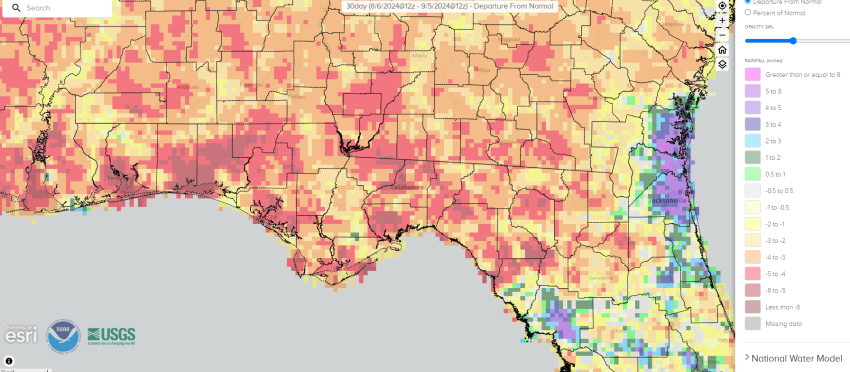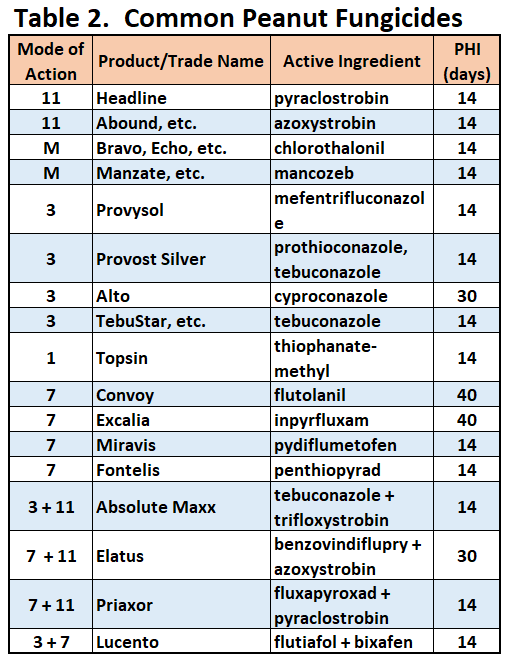Maturity Update
The aGDD Tracker below shows the number of adjusted Growing Degree Days (aGDDs) accumulated by 80 fictional fields (8 locations x 10 planting dates) as of 9/5/24. Real temperature and rainfall data from each location is used as well as common soil types for the areas (Jay – sandy loam, Marianna – loamy sand, Marianna Irrigated – sand, Monticello – loamy sand, Live Oak and Bronson – sand). Peanuts reach physiological maturity after the accumulation of approximately 2500 Growing Degree Days and the aGDD Tracker quantifies their progress. Use the Tracker to approximate how your fields are progressing by following the field that are the most similar to yours in terms of planting date, location and irrigation status. If the aGDD value shown for your field is black (under 2300), it’s probably not time to dig. If it’s yellow (between 2300 and 2500), you’re getting close; it’s time to pull samples and pod-blast to fine tune your harvest timing. Orange (2500+) means it’s almost certainly time to harvest, but pod-blasting is always the best way to know for sure.
For more precise tracking of your fields, go to PeanutFARM.org and set up your fields in the system. You will be able to enter field specific rainfall/irrigation data and soil type. Temperature data will come from the closest FAWN weather station. If you are interested in setting up your own fields on PeanutFARM.org, don’t hesitate to contact me for assistance.
aGDD Tracker for the Florida Peanut Producing Region – 9/5/24 edition
Table 1. The aGDD Tracker is compiled from data generated by PeanutFARM.org. The dark blue bars, in the cells behind the aGDD values, indicate progress towards 2500 aGDDs. The bar extends to the right as aGDDs are accumulated. The entire cell will be dark blue when a field has accumulated 2500 aGDDs. It is recommended that fields be sampled and exact days-to-harvest be determined via pod-blasting once a field reaches 2300 aGDDs.
In the 21 days since the previous aGDD Tracker was published, all fields have progressed considerably. This is to be expected since temperature is the primary factor dictating the speed at which GDDs are accumulated – it’s been plenty hot. However, let us not forget about the “a” in aGDD. The “a” is for “adjusted“, as in adjusted for available moisture. Drought conditions slow the accumulation of aGDDs. This is the primary reason why when you look at the aGDD Tracker all the mature fields are irrigated. In the locations where we are tracking irrigated and rain-fed fields, the irrigated fields are 200 to almost 500 aGDDs ahead of the rain fed fields. With the older fields being the farthest ahead. Another way to illustrate the same phenomenon is to look at the rate of accumulation over the past 21 days. Across all locations the rain-fed fields are averaging 17.2 aGDDs per calendar day, while the irrigated fields are averaging 20.3 aGDDs per calendar day.
Irrigated fields are tracking ahead of the 140 day calendar and rain-fed fields are starting to fall behind. If it stays hot and dry, we expect to see the maturity gap between rain-fed and irrigated fields to continue to increase. This problem will further compound, especially with the later planted rain-fed fields, as the coming shorter days and cooler nights begin to slow fields even more. The moral of the maturity story is the same as it always is – use the aGDD Tracker to get close, then pull good samples and pod-blast to fine tune. For help with pod-blasting, call your local County Extension Office – we’re here to help.

Departure from normal rainfall for the 30 days prior to 9/5/24. Dry conditions are slowing the maturity of rain-fed peanut fields across the majority of the peanut producing region of Florida. Source: https://water.noaa.gov/
–
Peanut Disease Update
Peanut Rust is spreading across Florida, including Jackson County!
Not every field will struggle with peanut rust, but some may, so it is good to be prepared. Research has shown that azoxystrobin (e.g. Abound) and pyraclostrobin (e.g. Headline) are very effective at managing peanut rust. Treatments with chlorothalonil (e.g. Bravo) and tebuconazole (e.g. TebuStar) have also provided adequate rust management. However, only chlorothalonil and pyraclostrobin treatments provided adequate late leaf spot management as well. If using Miravis and rust is a concern for the field, it will need combined with a fungicide that has additional activity on rust. Peanut fields range in age/maturity from digging within the next week to over 30 days from harvest . Early and late leaf spot, as well as white mold can be found in most commercial fields at varying levels now.
It is important to follow the label and all pre-harvest interval restrictions associated with the different products. Table 2 below compares common peanut fungicides with differnt modes of action and pre-harvest intervals (PHI). Note, this is not an exhaustive list and does not replace the information on the product labels.
Products can vary in efficacy and disease control depending on the disease trying to be managed. For questions, contact your local Extension Office.
- Peanut Maturity Update – 10/9/25 - October 10, 2025
- Fall Can be a Great Time for Vegetation Management - October 3, 2025
- Peanut Maturity Update – 9/25/25 Edition - September 26, 2025

